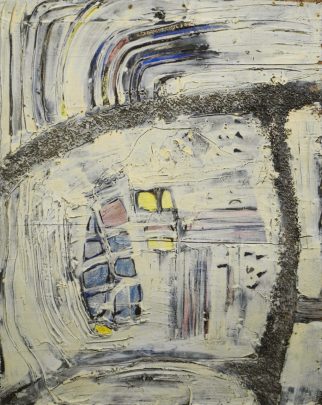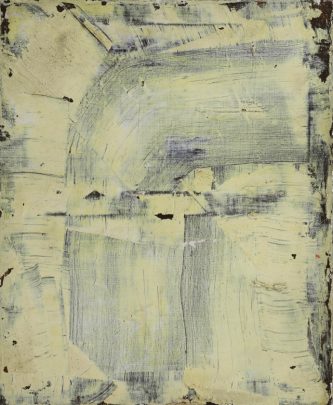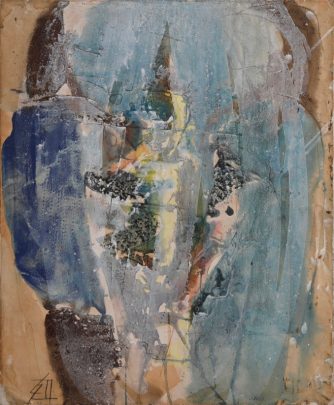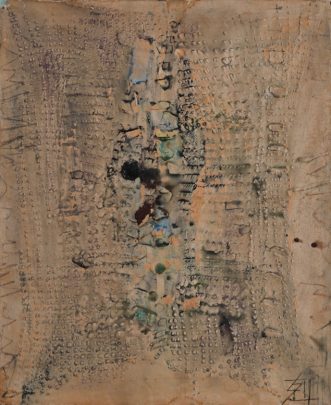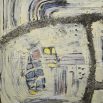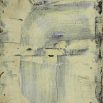須田剋太 SUDA Kokuta 1906–1990
- 無題 1959-1963年 ミクストメディア(油彩、小石他)・ウッドパネル 91x72.7cm 販売済み
untitled 1959-1963 mixed media (oil painting, gravel, etc.) on wood panel 91x72.7cm sold - 無題 1959年 ミクストメディア(色紙のコラージュ他)・ドンゴロスキャンバス 91.5x66cm
untitled 1959 mixed media (collage of colored paper, etc.) on dungaree canvas 91.5x66cm - 作品 1964年 油彩・キャンバス 61x50cm 販売済み
Work 1964 oil on canvas 61x50cm sold - 生命体 1959年 ミクストメディア・紙、キャンバスに裏打ち 73x53cm
A life form 1959 mixed media on paper, backed on canvas 73x53cm - 無題 1959年 ミクストメディア・紙、キャンバスに裏打ち 53.5x45.5cm
untitled 1959 mixed media on paper, backed on canvas 53.5x45.5cm - 近代の記号 1959年 ミクストメディア・紙 65x52.5cm
Sign of modern era 1959 mixed media on paper 65x52.5cm
明治39年(1906)、埼玉県北足立郡吹上町(現埼玉県鴻巣市)に生まれる。東京美術学校を受験するが4度にわたり失敗。寺内萬治郎に見いだされ光風会に所属し、昭和14年(1939)と同17年の新文展で特選となった。戦時中は奈良で過ごし杉本健吉等と交流し、戦後に兵庫県西宮市に移り住んだ。同24年に光風会を退会して国画会会員となる。また現代美術懇談会に参加し、ゲンビ展に作品を出品した。戦後の前衛美術の影響を受け抽象画を描く一方、具象画も描き、さらに書や作陶にと貪欲に造形の幅を広げた。同45年からは、司馬遼太郎が『週刊朝日』に連載した「街道をゆく」の挿絵を担当する。個性的な作風や人柄が愛されて人気を集め、多くの個展を開催した。平成2年(1990)、84 歳で逝去。
<飯田市美術博物館 コレクション展示 須田剋太ーひろがる造形 作品リストより引用>
Born in Saitama Prefecture and after finishing school, Suda studied drawing at Kawabata Drawing School before leaving to continue studying on his own. At this early stage he had two failed applications for Tokyo School of Fine Arts (Tokyo Bijutsu Gakko) however he was not discouraged and continued to show his work at state exhibitions including Bunten and Shin-Bunten, winning various awards in 1936, 1939 and 1942.
In 1948 Suda became a member of Han Artists Association (Han Bijutsu-ka Kyokai); a group founded by Jiro Yoshihara. Up until this point Suda's work had been largely figurative, however in 1949 he was introduced to abstract painting by the influential avant-garde painter Saburo Hasegawa and he also worked to deepen his knowledge of Zen Buddhism. At this time his work changed to abstract expressionism.
During the 1950's, groups of artists shared a common interest in exerting freedom of expression, separate from the influence of the antiquated art associations. In 1952 Suda co-founded the Modern Art Discussion Group (Genbi) which provided a forum for discussions on art theory and practice amongst its members who also included Jiro Yoshihara and Shiryu Morita; these discussions would later form the foundations of Gutai group founded by Yoshihara in 1954. Interestingly Suda was invited to join Gutai group however he declined in order to follow his own path.
In 1975 Suda participated in a group exhibition at Hyogo Prefectural Museum of Art, Kobe, titled 'Four Abstract Artists', alongside artists Kazuo Shiraga, Waichi Tsutaka, Sadamasa Motonaga, as well as participating in many other group and solo exhibitions both internationally and in Japan.
In 1980's his life-long interest in both calligraphy and Buddhism came to the fore and he began to focus on producing bold calligraphic works featuring Buddhist dictums.
Work by the artist has entered numerous museum collections including The National Museum of Art, Osaka, and LACMA.
